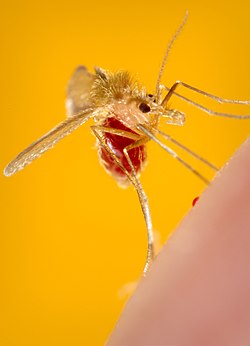Phlebotomus papatasi
| Phlebotomus papatasi | |
 | |
| Systematik | |
|---|---|
| Domän | Eukaryoter Eukaryota |
| Rike | Djur Animalia |
| Stam | Leddjur Arthropoda |
| Understam | Sexfotingar Hexapoda |
| Klass | Egentliga insekter Insecta |
| Ordning | Tvåvingar Diptera |
| Familj | Fjärilsmyggor Psychodidae |
| Släkte | Phlebotomus |
| Art | Phlebotomus papatasi |
| Vetenskapligt namn | |
| § Phlebotomus papatasi | |
| Auktor | (Scopoli, 1786) |
| Synonymer | |
| Phlebotomus breviventris Ristorcelli, 1941 Haemasson minutus Loew, 1844 Ciniphes molesta Costa, 1840 | |
| Hitta fler artiklar om djur med | |
Phlebotomus papatasi[1] är en tvåvingeart som först beskrevs av Giovanni Antonio Scopoli 1786. Phlebotomus papatasi ingår i släktet Phlebotomus och familjen fjärilsmyggor.[1][2] Inga underarter finns listade i Catalogue of Life.[1]
Arten är en vektor för parasiterna Leishmania tropica[3] och Leishmania major som kan orsaka sjukdomen leishmaniasis.[4].
Källor
- ^ [a b c] Bisby F.A., Roskov Y.R., Orrell T.M., Nicolson D., Paglinawan L.E., Bailly N., Kirk P.M., Bourgoin T., Baillargeon G., Ouvrard D. (red.) (5 september 2011). ”Species 2000 & ITIS Catalogue of Life: 2011 Annual Checklist.”. Species 2000: Reading, UK. http://www.catalogueoflife.org/annual-checklist/2011/search/all/key/phlebotomus+papatasi/match/1. Läst 24 september 2012.
- ^ Systema Dipterorum. Pape T. & Thompson F.C. (eds), 2011-01-06
- ^ Schiein, Yosef (1987-12-01). ”Oskar Theodor (1898–1987) in memoriam” (på engelska). Phytoparasitica 15 (4): sid. 345–346. doi:. ISSN 1876-7184. https://doi.org/10.1007/BF02979551. Läst 2 juni 2019.
- ^ Alemayehu, Mihiretu; Alemayehu, Bereket (2017-09-04). ”Leishmaniasis: A Review on Parasite, Vector and Reservoir Host” (på engelska). Health Science Journal 11 (4). doi:. ISSN 1791-809X. http://www.hsj.gr/abstract/leishmaniasis-a-review-on-parasite-vector-and-reservoir-host-20131.html. Läst 2 juni 2019.
|
Media som används på denna webbplats
This photograph depicts a Phlebotomus papatasi sandfly, which had landed atop the skin surface of the photographer, who’d volunteered himself as host for this specimen’s blood meal. The sandflies are members of the Dipteran family, Psychodidae, and the subfamily Phlebotominae. This specimen had just completed its ingestion of its bloodmeal, which is visible through its distended transparent abdomen. Sandflies such as this P. papatasi, are responsible for the spread of the vector-borne parasitic disease leishmaniasis, which is caused by the obligate intracellular protozoa of the genus Leishmania.
